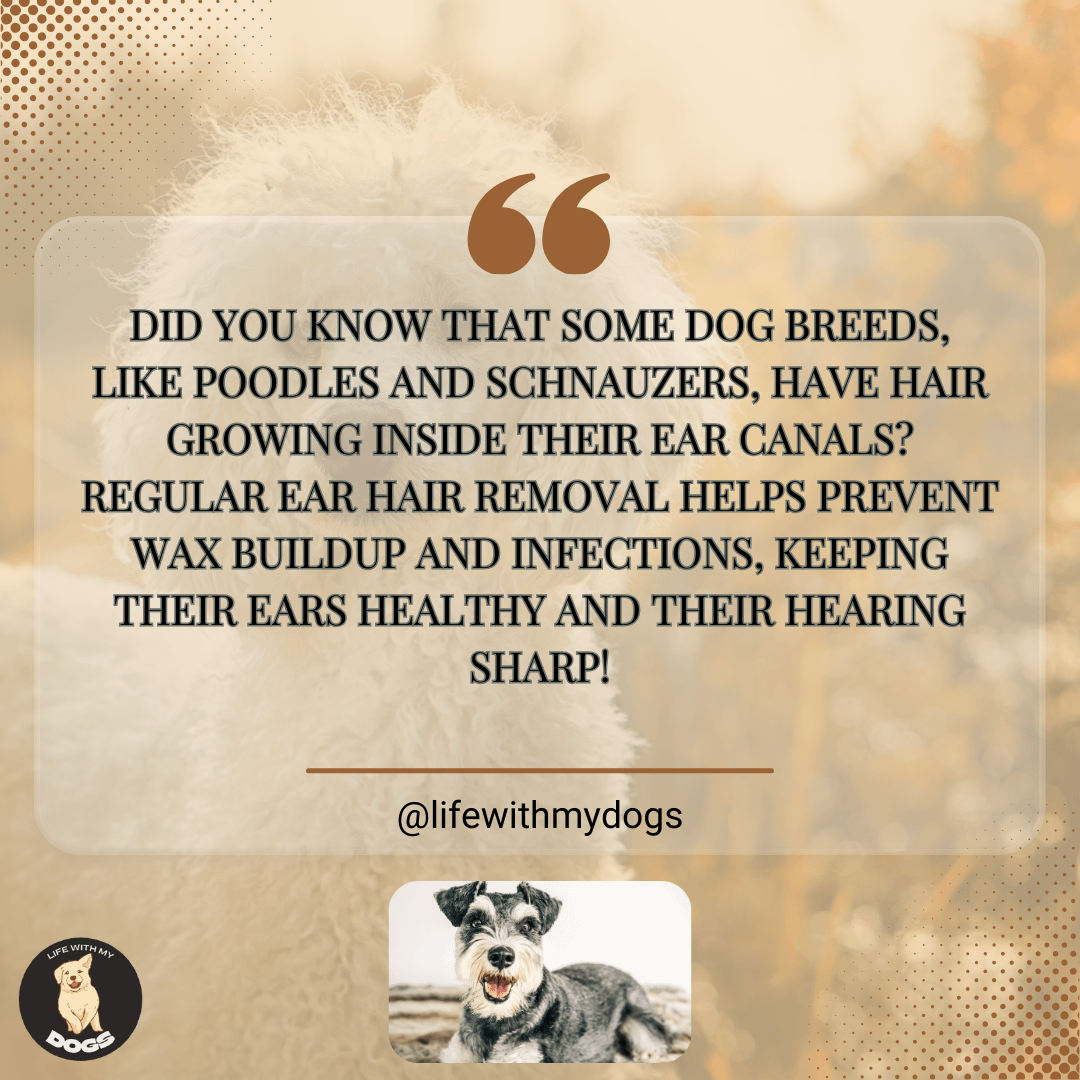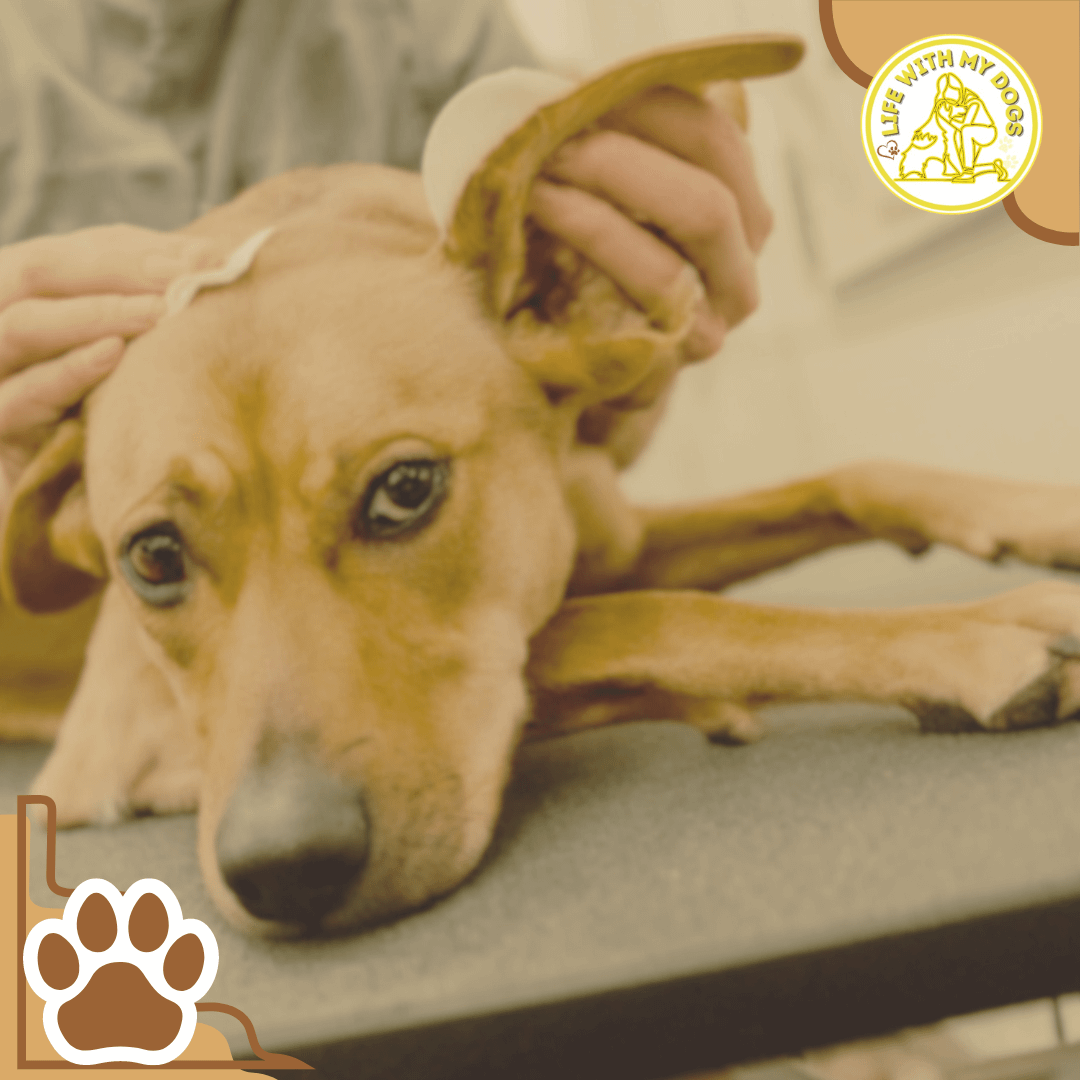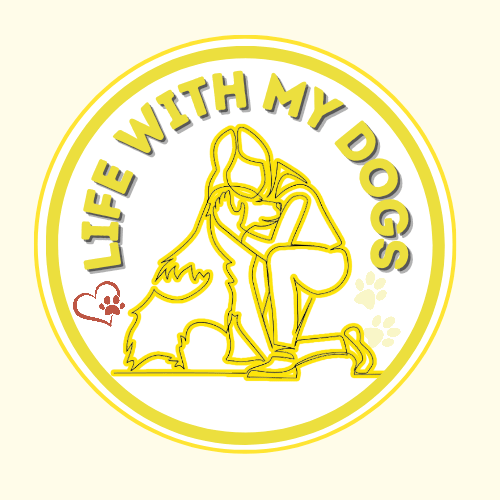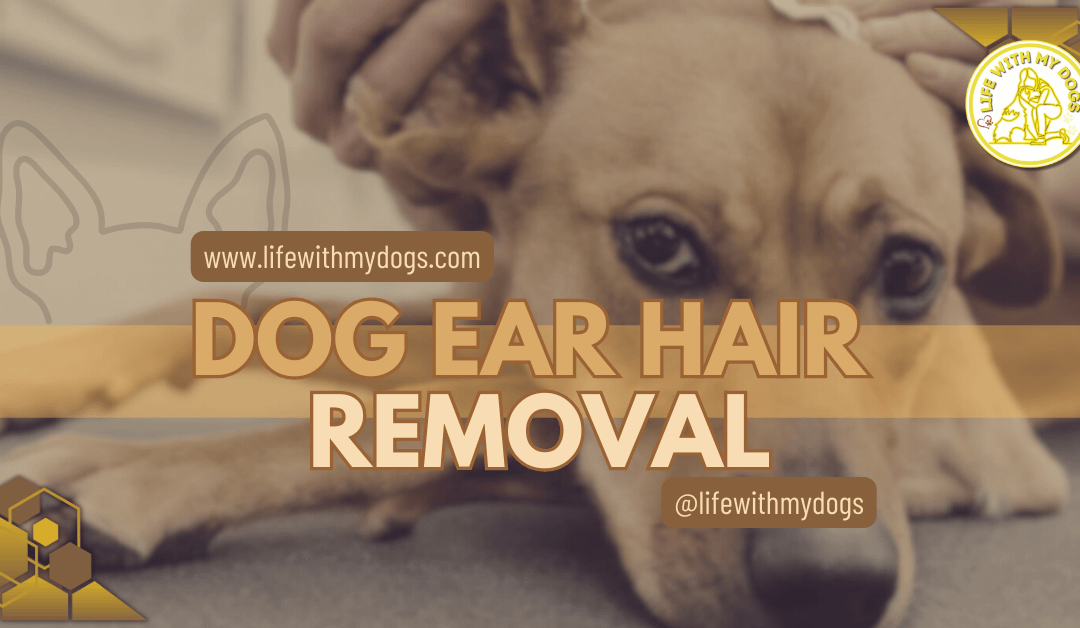LifeWithMyDogs is supported by our audience. When you purchase through one of our links, we may earn a small affiliate commission. As an Amazon Associate I earn from qualifying purchases. Your cost is not affected.
**********
Dog ear hair removal. It’s not exactly the most glamorous aspect of pet ownership, but let’s be honest, who hasn’t peeked inside their furry friend’s ears and wondered about all that fur down there? While some breeds seem to have a permanent case of ear fuzzies, you might be surprised to learn that excessive ear hair can actually cause problems for your pup. From discomfort and infections to that constant head shaking that drives you crazy, keeping your dog’s ears clean and free of excess hair is an important part of their overall health and well-being. But where do you even begin? Fear not, fellow pet parent!
This guide will walk you through everything you need to know about dog ear hair removal, from the signs to watch for to the safest and most effective removal techniques. So, grab your dog’s favorite treats, find a comfy spot, and let’s get those ears sparkling clean!
Dog Ear Hair Removal: Tips for a Healthy Pup
Is your dog’s ear hair driving you both nuts? That fuzzy forest can trap moisture, leading to itchy irritation and even nasty infections. Ugh! Keeping your pup’s ears clean and healthy is ruffly important, and removing some of that ear hair can be a real game-changer.

The good news? Plucking ear hair can be a breeze, as long as you do it carefully. We’re talking about using rounded shears, slicker brushes to grab loose hair, and maybe even a gentle shave if things get a little matted. But before you grab the scissors, there are a few things you need to know. Like, how to tell if your dog needs a professional groomer’s touch, and how to keep those ears sparkling clean after your home hair removal mission.
This guide will be your fur-ever friend in the battle against ear hair. We’ll walk you through the signs of too much fuzz, the benefits of getting rid of it, and some easy steps to keep your dog’s ears happy and healthy. So, let’s get those ears floppin’ with confidence!
Key Takeaways
- Keep your dog’s ear hair trimmed to prevent infections.
- Use gentle tools and techniques for ear hair removal.
- Regular maintenance ensures clean and healthy ears.

Understanding Ear Hair in Dogs
It might surprise you, but just like us, dogs have ear hair! And believe it or not, that fur growing inside their floppy ears has a purpose. It turns out, the amount of ear hair can differ depending on the breed, and understanding this can help you keep your pup’s ears healthy and happy.

Function of Ear Hair
Ear hair helps protect your dog’s ears from dirt, debris, and insects. It acts as a barrier, preventing foreign objects from entering the ear canal.
This hair also helps to reduce the risk of ear infections by keeping harmful particles out.
Keeping the ear canal clean and free from obstructions is critical for your dog’s ear health.
Ear hair can also regulate temperature by aiding in the heat exchange process inside the ear.
This keeps your dog’s ears cool in warm weather and warm in cooler temperatures.
Breed Variations
Different dog breeds have varying amounts and types of ear hair. Breeds like Poodles and Shih Tzus often have longer, thicker ear hair that needs regular grooming to prevent matting and infections.
Breeds such as Labrador Retrievers and Beagles typically have shorter ear hair, requiring less maintenance but still benefit from occasional cleaning.
Some breeds are prone to ear infections due to their ear structure and hair type, making regular ear care more important. For instance, Cocker Spaniels and Basset Hounds fall under this category.
The grooming needs for ear hair can vary widely, so it’s essential to know what is best for your dog’s specific breed.
Signs of Excessive Ear Hair

While some ear hair is normal for dogs, too much can lead to some yucky problems. We’re talking clumps of fur getting stuck, funky smells coming from their ears, and your pup shaking their head or scratching their ears constantly. It’s definitely not pleasant for them!
Visible Clumping
When your dog has too much ear hair, you may see clumps forming inside their ears.
These clumps can tangle and mat, making it hard for air to circulate. This lack of airflow could trap moisture, which often leads to infections.
Regularly checking your dog’s ears helps you spot these clumps early.
Odor and Discharge
Strong smells and unusual discharge from your dog’s ears can signal too much hair.
The extra hair can trap dirt, wax, and bacteria. This creates a breeding ground for infections.
If you notice a bad odor or yellowish discharge, it’s time to examine your dog’s ear hair and possibly seek veterinary care.
Scratching and Head Shaking
Constant scratching and frequent head shaking are typical signs of excessive ear hair in dogs.
These behaviors usually indicate discomfort or itchiness caused by the hair.
If your dog scratches their ears a lot or shakes their head often, excessive ear hair might be the culprit. Regular grooming can help alleviate these issues.
Benefits of Ear Hair Removal
Removing hair from your dog’s ears can help prevent infections and enhance their comfort. Both of these benefits are crucial for the overall health and happiness of your pet.
Preventing Infections
Ear hair removal helps to keep your dog’s ears clean, reducing the risk of infections.
When hair builds up in your dog’s ears, it can trap moisture and dirt, creating a breeding ground for bacteria and yeast.
These can lead to painful ear infections that might require medical treatment.
Grooming the hair also allows better airflow in the ear canals.
Proper air circulation helps keep your dog’s ears dry, further preventing infections.
Regular hair removal can be an essential part of your dog’s hygiene routine to keep their ears healthy.
Enhancing Comfort
Excessive ear hair can cause discomfort for your dog.
It can irritate the delicate skin inside the ear, leading to itching and scratching.
This discomfort can cause your pet to shake their head frequently, which might even lead to further complications like ear hematomas.
By removing the hair, you can help your dog feel more comfortable.
They will likely scratch and shake less, which means fewer chances of injury.
Treating your dog to a gentle grooming session can also be a bonding experience and can make them feel more at ease.
Preparation for Hair Removal
Before you dive in and start trimming your dog’s ear hair, it’s important to gather the right supplies and make sure your furry friend is nice and relaxed. Here’s what you need to do to get prepped:

Gathering the Right Tools
Start by collecting rounded shears, which are safer for trimming near delicate skin.
You’ll also need a slicker brush to gently brush out mats.
For stubborn mats, use ear hair removal powder, which helps you get a better grip on the hair.
You should also have clean cloths or cotton balls ready. These are for wiping away loose hair and preventing it from going into your dog’s ear canal.
Consider a clean towel or mat to work on, so your tools stay tidy.
Finally, don’t forget treats. They help make the experience positive for your dog.
Treats can be given before, during, and after the hair removal to keep your dog happy and calm.
Setting Up a Calm Environment
Choose a quiet, familiar spot for the process. Dogs are more relaxed in a place they know well.
Make sure there are no distractions like loud noises or other pets around.
Lay down a towel or mat to keep your dog comfortable.
Position them in a way where you can easily access their ears without causing stress.
Speak softly and calmly to your dog throughout the procedure.
Keep your movements slow and gentle.
Starting with a few petting strokes helps your dog understand they’re safe.
If your dog becomes anxious, take a short break and offer a treat to reassure them.
The key is to keep the atmosphere soothing and stress-free.
Step-By-Step Ear Hair Removal Process
Taking care of your dog’s ear hair is important to keep their ears clean and healthy, and prevent nasty infections. But how do you do it safely? The key is using the right tools and gentle techniques for trimming and, if needed, some careful plucking.

Trimming Techniques
Start by choosing specialized ear hair removal tools designed for dogs.
Rounded shears are a good option to avoid accidental cuts.
Carefully inspect your dog’s ears for excess hair, matted hair, or dirt buildup.
Use the rounded shears to trim away any mats at the base of your dog’s ear.
Clip the mats in half lengthwise, then brush any remaining mat with a slicker brush.
If the mats are too stubborn, you might need to shave the ear hair completely.
After trimming, clean the ears with a good cleaning solution to remove any debris.
Plucking Safely
Plucking ear hair can be tricky, but with patience, you can do it safely and painlessly.
First, use ear powder to help grip the hair more easily.
Gently pull small amounts of hair at a time to avoid causing pain.
Be patient and go slowly.
Pluck in the direction of hair growth to reduce the chance of discomfort.
After you’ve finished plucking, use a clean cloth or cotton ball to wipe away any loose hair. This prevents hair from getting into the ear canal.
Reward your dog with a treat after the process to make it a positive experience.
Aftercare Following Removal
After removing hair from your dog’s ears, it’s key to clean the ear canal and watch for any signs of irritation. Proper aftercare helps keep your dog’s ears healthy and prevents infections.
Cleaning the Ear Canal
Start by wiping away any loose hair from the ear. Use a clean cloth or cotton ball.
Apply a gentle canine ear cleaning solution to the cloth.
Carefully clean the ear flap and the accessible part of the ear canal.
Do not push anything deep into the ear. This can hurt your dog or push debris further inside.
For extra cleanliness, use tweezers designed for ear hair or hemostats. Ensure they are clean to avoid infections.
Wipe the ears once or twice a week or as recommended by your vet.
Monitoring for Irritation
Keep an eye on your dog’s ears for signs of redness, swelling, or discharge. These can indicate irritation or infection.
If your dog scratches their ears a lot, shakes their head, or shows discomfort, it could be a problem.
Check the ears regularly during grooming sessions.
Ensure you use gentle products and tools to avoid causing irritation.
If you notice any issues, contact your vet right away. Early detection can help treat problems before they worsen.
Tips for Regular Maintenance
Regular maintenance of your dog’s ear hair is crucial for preventing issues such as ear infections and discomfort.
Staying on top of grooming routines and using effective techniques can make the process smoother and more comfortable for your furry friend.
Scheduling Routine Grooming
It’s important to set up a consistent grooming schedule.
Aim to check your dog’s ear hair at least once a month.
Regular grooming helps catch hair build-up before it becomes problematic.
You might find that some breeds need more frequent checks due to faster hair growth.
Make these grooming sessions a part of your dog’s routine to help them get comfortable with the process.
Home Grooming Best Practices
When grooming at home, use the right tools like rounded shears and a slicker brush.
Start by gently rolling small sections of hair and pulling swiftly to avoid discomfort.
After removal, clean the ear using a canine ear cleaning solution on a cotton ball.
Wipe the inner flaps without going deep into the ear canal. This ensures you remove loose hairs and debris effectively.
If you’re unsure or your dog seems stressed, consider seeking help from a professional groomer to ensure a pain-free experience.
Professional Grooming vs. At-Home Care
Caring for your dog’s ear hair can be done by both professionals and at home.
Each method has its unique benefits and costs that you might want to consider.

When to Seek Professional Help
You should consider professional grooming if your dog has sensitive skin or a history of ear infections.
Professional groomers have specialized shampoos for different skin types, ensuring your dog’s comfort.
They also check for signs of irritation and clean the ears thoroughly.
Professionals use tools like clippers with appropriate guard lengths and specialized ear cleaning solutions.
If you’re new to grooming or nervous about hurting your dog, seeking a professional is usually the best choice.
Comparing Costs and Benefits
Professional grooming tends to be more expensive than doing it yourself at home.
Grooming sessions can range from $30 to $90 depending on your dog’s size and breed.
The costs cover bathing, trimming, and ear cleaning using specialized products and tools.
At-home care is more budget-friendly.
You will need clippers or scissors, a hair removal tool, and an ear cleaning solution.
Initial costs may be higher for tools, but the long-term savings are significant.
At home, you also get the advantage of bonding time with your dog, but it requires patience and a bit of practice to avoid causing discomfort or injury.
Common Mistakes to Avoid
When removing hair from your dog’s ears, there are several common mistakes you should avoid to keep your furry friend comfortable and safe.

Using the Wrong Tools: Make sure to use specialized ear hair removal tools designed for dogs. Regular scissors or tweezers can be unsafe and cause pain.
Plucking Healthy Hair: Don’t pluck healthy hair. This can be very painful and might even lead to inflammation and infections.
Not Using Ear Hair Removal Solutions: Using an ear hair removal solution designed for dogs can make the process easier and less uncomfortable for your dog.
Over-Trimming: Avoid trimming too much hair. Dogs need some ear hair to protect their ears from debris and insects.
You should trim only the excess hair around the ear opening, as recommended by veterinary experts.
Skipping Professional Advice: Always consider consulting with a professional groomer or veterinarian for guidance. This can help ensure you are doing what’s best for your dog’s ear health.
Dog Ear Hair Removal: A Pawsitive Experience for You and Your Pup
Remember that peek you took at your dog’s ears, wondering about all that fur? We covered how excessive ear hair can lead to discomfort, infections, and that head-shaking frenzy. But worry no more! This guide has equipped you with the knowledge to tackle dog ear hair removal with confidence.

We explored the signs of too much ear hair, the benefits of keeping ears clean, and the different methods for safe removal at home. You learned about the importance of gentle tools, regular maintenance, and when to seek professional help. Now, armed with this knowledge, you can ensure your furry friend’s ears are healthy and comfortable.
So, grab those treats, find a quiet spot, and get ready to bond with your pup during a much-needed grooming session. Remember, a little care goes a long way in keeping your dog happy and healthy. We wish you both the best of luck, and happy grooming!
Frequently Asked Questions
When it comes to removing ear hair from your dog, there are specific methods and products you can use safely.
Different dog breeds have varying needs, and professional groomers often offer this service.

What is the best way to remove hair from my dog's ears at home?
Gently remove small amounts of hair at a time using your fingers or a hair removal tool.
Be careful not to pull too hard to avoid hurting your dog.
For more detailed steps, you can visit this guide on removing hair from a dog’s ears.
Is there a specific cream that is safe for removing my dog's ear hair?
Most commonly, ear powders designed for dogs are used rather than creams.
Powders make it easier to grip and remove the hair.
Check with your vet before using any new product to ensure it’s safe for your dog.
What types of dogs typically require ear hair removal?
Breeds with long or curly hair, like Poodles and Cocker Spaniels, often need ear hair removal.
These breeds are prone to ear infections because their ear hair can trap moisture and debris, which can lead to infections.
Are there professional services that specialize in dog ear hair removal?
Yes, many professional groomers provide ear hair removal services.
Vets can also perform this task, especially if your dog is prone to ear issues. They have the expertise to do it safely and effectively.
How do groomers handle ear hair removal, and is it a necessary service?
Groomers use tools like hemostats or tweezers to pluck ear hair quickly and gently. It helps improve airflow and reduce the chance of infections, making it an important part of a grooming routine.
For more insights, you can check out this detailed article on ear hair removal by groomers.
Unleash the Fun of Dog Grooming!
Want to up your dog’s grooming game?
Join our fur-tastic community on Life With My Dogs!
We share pawsome content, product reviews, and grooming tips across all our channels:
- Facebook: Follow Us
- Instagram: @LifeWithMyDogs2
- Pinterest: Pin with Us
- Twitter: @LifeWithMyDogs9
- YouTube: Subscribe Now!
Let’s make dog care fun and fabulous together!


